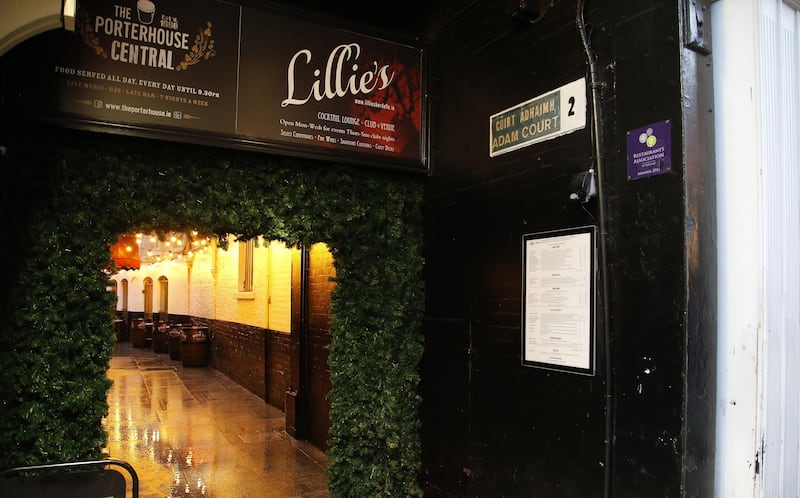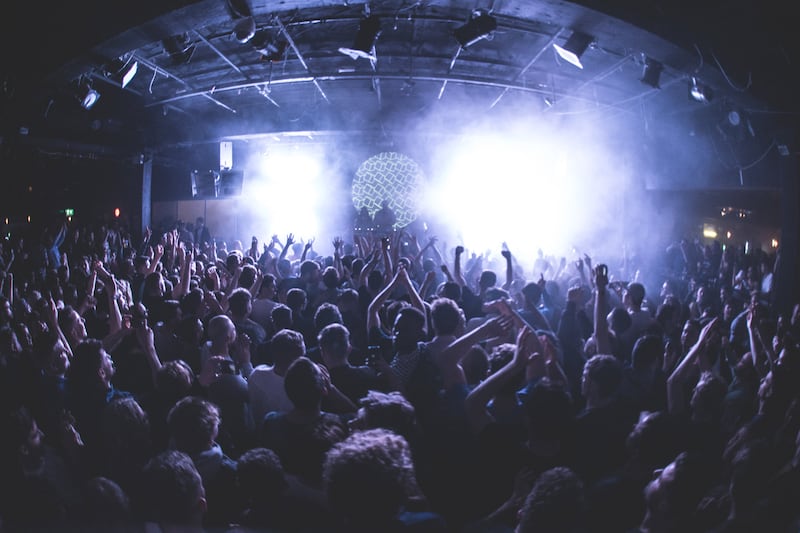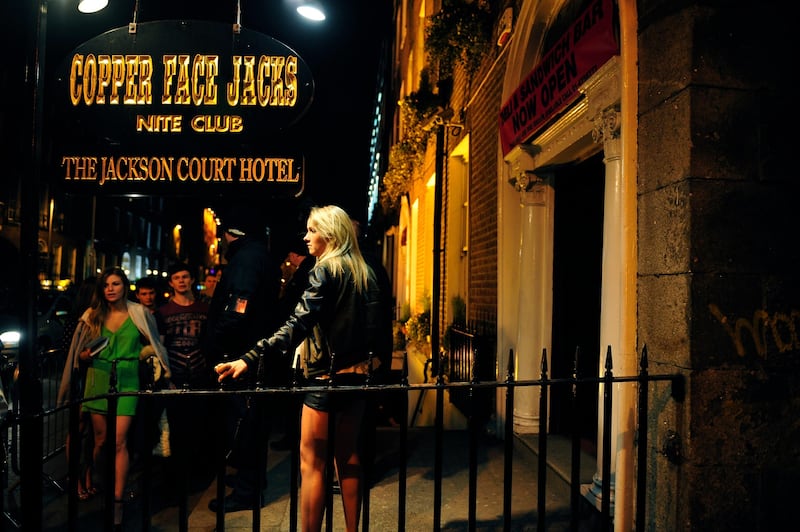As midnight approached, a blacked-out people carrier drew up outside the Wright Venue. Out stepped Rihanna, in the same dress she’d worn on stage before 14,000 fans less than an hour earlier.
It was May 26th, 2010, and one of the world’s biggest pop stars had come to the €38 million megaclub – situated in a retail park bristling with car dealerships and DIY stores in north Co Dublin – for her aftershow party.
Hosting Rihanna and her retinue was obviously a coup for the Wright Venue and its owner, the restaurateur Michael Wright. The Swords club had opened amid glittering fanfare in July 2009 and, notwithstanding the half-hour drive from the city centre, was building a reputation as the decompression spot of choice for celebrities passing through Dublin.
Conor McGregor and 50 Cent would likewise grace the Wright Venue, partying beneath the “largest disco ball in Ireland”. They and their entourages were typically catered for in the Scarface Room – named after the Al Pacino movie about a Cuban cocaine magnate – which offered VIP access via a dedicated lift. A little bit of Miami’s South Beach had washed up in the Dublin exurbs.
But now it is set to be swept out to sea again. Michael Wright has announced that, after almost 10 years, the club is to be shuttered at the end of January. He is focusing on other ventures, including a food hall planned for St Andrew’s Church on Suffolk Street in central Dublin.
Jam Park will still be a nightclub of sorts, but no longer the Versailles of bling that was the Wright Venue
Under the new name of Jam Park, the Wright Venue will be taken over by the promotion company Bodytonic, whose plans include a games room and restaurant as well as a performance area. In other words, it will be a nightclub, but not entirely, and certainly no longer the Versailles of bling that was the Wright Venue.
So it goes in Irish nightlife in 2019. On January 26th the popular District 8 club night will host its farewell evening at the Tivoli theatre in Dublin. Once the lights dim that will essentially be it for the Tivoli, which was built in 1934, and has used as a club and venue since 1987, but is now earmarked for demolition. Rising in its place will be an apartment-hotel complex with a gym and restaurant.
Also for the chop is Lillie’s Bordello, a celebrity playroom since before the Celtic Tiger era. David Bowie, Mick Jagger and Guns N’ Roses were among those to make the trek to its then-unmarked entrance down a lane off Grafton Street. There, having run the gauntlet of its disapproving doormen, they would mingle with the cream of the local Z-list. It closes for good on January 19th, its owner, the Porterhouse Group, has confirmed.

An extinction event
The Wright Venue, Lillie's and the Tivoli are merely the highest-profile victims of an extinction event rippling across Irish clubland. Others caught in the firestorm include the Palace, on Camden Street, where much of The Commitments was shot, Club 92, in Leopardstown and, to step back several years, the Savoy and Pavilion, in Cork.
A thriving nightclub is as rare a sight in Irish cities as a cyclist stopping at a red light.
Tellingly, these announcements have elicited little beyond a regretful shrug. The imminent closure of Lillie’s, it is true, prompted teary reminiscing among those who clinked champagne flutes with Bono and The Corrs back in the day.
Absent from even those outpourings, though, was any genuine shock – much less any serious pleas for a stay of execution.
The downfall of the Irish nightclub did not drop from the clear blue sky. Instead it is the product of a unique concurrence of events: the property crisis, indifference at official level to Ireland’s late-night culture and an unlikely outbreak of puritanism among twentysomethings.
Taken together, it constitutes a perfect storm: the murder of the dance floor.
People are looking for more of an experience nowadays. You can't just have the trifecta of a smoking area, dance floor and a bar
“People are looking for more of an experience nowadays. You can’t just have the trifecta of a smoking area, dance floor and a bar. You have to do something that entertains,” says Will Meara, a promoter who has had nationwide success with Bingo Loco – tongue-in-cheek bingo evenings for young people held in more intimate venues, such as the Twenty Two Club, off South Anne Street in Dublin.
Ireland isn’t alone in seeing clubs die off. In the UK a parallel cultural shift from all-hours boozing has resulted in the “afterwork economy” declining in value by more than €200 million in the past five years, with once-prestigious rooms reopening as gyms or food markets.
“If you’re a promoter you can’t survive on clubbing,” says Stephen Grainger, who ran the Pavilion bar and venue in Cork for seven years and who continues to have success with his Good Music nights in the city.
“What a lot of promoters have realised is that you have to turn the venues into a lot of different things. That’s why they’re not called clubs any more. Now they’re venues. Look at Bodytonic : they’ve done sports bars [the Back Page], food offerings [Wigwam]. Being successful today means doing a lot more than just sticking a DJ on. You can’t survive on people coming in for three hours once or twice a week.”
One irony is that, even as nightclubs slouch towards their obsolescence, other night-time options have proliferated. Dublin, in particular, has seen the opening of dozens of boutique bars and upscale cocktail lounges – viewed with a degree of hostility by club promoters who caution against “gentrification”.

No more hedonism
Another issue confronting clubbing is the diminishing appetite for hedonism among the young. In the age of social media, many people in their teens and early 20s are more conscious of health – and appearance – than previous generations. A party-heavy lifestyle is not necessarily compatible with that.
“We are more aware of the impact of going out and getting completely drunk every weekend,” says David Mooney, who has for the past decade run Funky Seomra, an alcohol and drug-free club night held at venues around Dublin.
“Around the 1990s and early 2000s you would see the nightclubs full. Part of this was a transition from Ireland being quite shackled as a society. Suddenly there was a lot of freedom. Today, people practise yoga, are aware of their diet. And they can see the effects of heavy drinking over time.”
An influx of young expats working at tech companies such as Facebook and Google has played its part, says Mooney. Forty per cent of attendees at his nights are non-Irish and often not from countries with drinking cultures. This has enhanced the appeal of Funky Seomra, Bingo Loco and similar events – and contributed to a dethroning of the nightclub as the only destination for an evening out.
The traditional “meat market” club has gone into decline. Dating apps such as Tinder and Bumble make it easier to meet people in locations other than noisy, dimly lit rooms.
“And individuals enjoy coming to events such as Funky Seomra because there is an opportunity to talk to people who aren’t really drunk,” says Mooney.
If clubbing faces similar challenges in other countries, what sets Ireland apart is that Dublin, Cork, Limerick and elsewhere lack even the basic infrastructure required for a functioning nightlife.
Dublin has the venerable Club M, in Temple Bar, and the unlikely national treasure that is Copper Face Jacks (Marty Morrissey if he were reincarnated as a Harcourt Street nightclub). But there is no equivalent of Fabric in London or Berghain in Berlin – institutions that culturally enrich their cities and, in their own modest way, enhance their status as global hot spots.
“There’s a huge lack of event space,” says Stephen Manning of Hidden Agenda, the promotions company behind District 8 and, before that, Hangar, at Andrew’s Lane Theatre (another former David Bowie hangout that has closed, to be redeveloped as a boutique hotel). “Hangar and District 8 had a capacity of 800 to 1,000. The next step up is the Olympia and 3Arena.”

Night mayors
District 8, in contrast to some of the more venerable clubs, has had little difficulty filling its dance floor. It has hosted sell-out late-night events by DJs and producers including Deadmau5, Death in Vegas and Daniel Avery.
But with the Tivoli to close, there is nowhere in central Dublin for Hidden Agenda to book performers. Manning and his partners have diversified with a new bar, the Big Romance, on Parnell Street. And they expect to hold gigs at Jam Park, which is set to open late this year. But the Swords location makes it less than ideal.
“If we have an act that sells 1,000 tickets, that’s too small for 3Arena and too big for anywhere else,” says Manning. “Those acts will go elsewhere. They just won’t come to Ireland. The only purpose-built spaces we are seeing are hotels or student accommodation.”
London, Zurich and other cities have “night mayors”, official appointees tasked with liaising between venue owners and the authorities. Yet despite vigorous lobbying by groups such as Give Us the Night, established by the Dublin DJ Sunil Sharpe, there is scant appetite at any level of government for an equivalent in any Irish city.
The problem, say campaigners, is cultural. Ireland is still in many aspects a conservative society. Our dwindling nightlife is an example of where decades-deep hostility towards activities perceived as decadent and hedonistic leads.
“Nightlife and nightclubs aren’t deemed to have any inherent cultural value,” says the DJ and promoter Jamie Behan. “The closures of District 8 and Hangar are the prime examples. The cultural value of nightclubs and the creative communities associated with them is not respected. We also have a government which has little or no interest in these matters or that of licensing laws. Compare this to European cities where nightclubs are an important part of the fabric of a city and are supported as such.”
A thousand blows
If Irish clubbing is suffering death by a thousand blows, one of the deepest cuts was inflicted in 2008, when the government radically overhauled the licensing laws with a new Intoxicating Liquor Act.
Among the wider public, the most contentious aspects of these “reforms” was the pushing forward of off-licence closing hours by 30 minutes, to 10pm. But the legislation also had hugely negative implications for nightclubs, in removing the old theatre-licence provision – judged “very lenient” by the cabinet – by which clubs could stay open past 3am. Theatre licences had facilitated sequential closing in Dublin, allowing clubs to shut at different times and so avoid a surge of people on to the streets.
Nightclubs were in that period generating sales estimated at €500 million, employing 2,000 full time and 10,000 part time. But even those figures were regarded as ominous. A report by the (now defunct) Irish Nightclub Industry Association found that the number of clubs had dropped by 37 per cent between 2000 and 2008. The new law – and the recession – saw that decline accelerate.
We have the shortest nightclub opening hours in Europe, when we could be a vibrant hub for electronic music
Sequential closing was no longer an option. All venues in the same licensing area had to abide by one curfew, with clubgoers all spilling out at the same time.
The advantages of staggered openings had been a matter of record when the legislation was enacted. After nightclubs in the “Garda B” district of south Dublin opted for sequential closing in 2006, the number of public-order prosecutions fell by 4.8 per cent over three years. At the same time the level of prosecutions outside the capital was rising by 25 per cent. Later opening was working.
One of the advisers to the Bill notoriously joked of having never seen the inside of a nightclub; it certainly seemed that way. The legislation also doubled the fee for the special-exemption order that clubs need to stay open late, and which is now costs about €400 a night.
“Our licensing system is so archaic it doesn’t just need to be re-examined or revamped,” says Jamie Behan. “It needs to be completely overhauled. We have the shortest nightclub opening hours in Europe, when we could be a vibrant hub for electronic music. People are going elsewhere, to Berlin, London, Amsterdam – cities which have demonstrated that 24-hour licences for clubs can work rather than result in the absolute moral decay of society due to alcohol abuse – the argument to which conservative naysayers repeatedly return.”
Night-time culture
“There’s a huge disconnect if you look at the makeups of Senators and TDs,” says Stephen Manning. “The regulations don’t distinguish between a nightclub and a bar. Places like Coppers or Club M, these are locations you might go to for a late drink. They are usually attached to a hotel. There’s a big difference between those and a dedicated space where someone is travelling to see an act. With those sorts of venues closing, it’s going to be very difficult to foster a night-time culture.”
Michael Wright of the soon-to-close Wright Venue agrees that the laws on opening hours pose a “real problem” to nightlife in Dublin. “Late-night bars have filled the nightclub space. Bars like Café en Seine, Pigmalion, Berlin, the Grand Social and the George don’t close until 2.30am – the same time as a nightclub. Generally you don’t have to pay in and you can dance for the night. It would make much more sense, and help the nightclub scene, if clubs stayed open later than late-night bars. This is a licensing error, and I would call for it to be reviewed if we are to re-energise Dublin’s nightlife. At the moment it is not a level playing field, and as far as nightclubs are concerned all roads lead to Harcourt Street.”
“Dublin is now very much a cosmopolitan city, and Ireland’s young people are very travelled. It is time to catch up with the other European cities where they stay open much later, giving clubs an opportunity to become part of the night-time culture.
But while the shuttering of the Tivoli and other venues is a cause of disquiet for some, it is important, too, to recognise that times change. People of a certain age wax nostalgic about the glory days of clubs such as Sir Henry’s, in Cork, and the Temple of Sound, in Dublin. Yet they would do well to remember that the treasured pursuits of a past generation may not be particularly relevant to millennials and Gen Z-ers.
“A lot of young people nowadays don’t even know what was going on back then,” says Stephen Grainger. “It is important to respect and document those times. And young people still like going out. But tastes in music don’t stay the same. Everything goes in cycles.”
“Dating has also changed,” Michael Wright points out. “Young people used to go out to a pub or nightclub to meet people. Now they are doing it online. We got dressed up and went out to try and meet someone. Now it’s a ‘Swipe Right’.”

Less dancing, more drink and drugs
FROM A POLICING POINT OF VIEW the decline of the nightclub, in Dublin at least, has had little affect on the night-time crime rate, writes Conor Gallagher.
In fact there is some evidence to show nightlife-related offending, such as assaults, drugs and public disorder, has increased in recent years.
According to the Dublin councillor Mannix Flynn, this is because people are still going out. In fact, because of the economic recovery more people than ever are hitting the tiles; they’re just doing it differently. Instead of going to nightclubs, they’re going to bars and cafe bars that have late licences. While many of these venues have dance floors, dancing is not the focus. “You’re looking at a lot more drinking and a lot more drug-taking in these places.”
Cocaine is more suited for pubs and late bars. With clubs the focus is always on ecstasy
Flynn, who sits on the inner-city joint policing committee, says people are dancing less and drinking more, leading to problems after closing, such as fighting and public-order incidents. “People aren’t going out to dance any more. That’s all changed. Assaults and public order are actually worse, because they are involving a lot more people. It’s nightlife, but it’s not nightlife clubbing.”
A rise in drug arrests, particularly for cocaine possession, has also been seen in recent years. Cocaine consumption is increasing in every town in the country and the decline of the nightclub has done nothing to slow it.
“Cocaine is a drug more suited for pubs and late bars rather than clubs. People nip off to the toilet to do a little between rounds. With clubs the focus is always on ecstasy,” says a member of a Garda drug team in Dublin.
Arrests relating to ecstasy have fallen significantly in recent years while arrests to do with cocaine have increased. People are also “far more likely” to get into fights after taking cocaine, further driving up the arrest figures, the garda says.
Dublin has also seen a increase in illegal raves in the past five years, but Garda sources say these are not much of a problem from a public-order point of view. “The feeling is they’re a different type of crowd. They don’t seem to drink as much,” a garda based at Pearse Street station says.




















